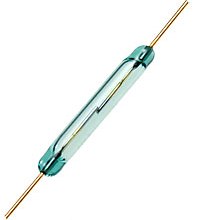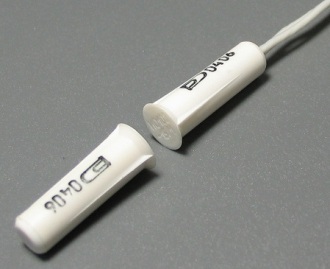Categories: Featured Articles » Home automation
Number of views: 19835
Comments on the article: 1
Reed Sensors
 Reed sensors are common as sensors for opening doors and windows, to protect against intrusion into objects, in security systems.
Reed sensors are common as sensors for opening doors and windows, to protect against intrusion into objects, in security systems.
These magnetic contact sensors are installed on doors, gates, windows and any other massive structures and objects that need to be protected from unwanted opening, movement, or destruction.
Reed switch (sealed contact) is the main element of such a sensor, and makes it reliable, safe, and durable, at a low cost, security component.
The reed switch is a hermetically sealed glass cylinder, in which two permalloy contacts are usually placed, and the medium inside the cylinder is high pressure nitrogen, which eliminates oxidative processes inside this important electronic component. Its contacts are coated with special metal, such as molybdenum, titanium, tungsten or gold, this gives them durability and wear resistance (the working life of the reed switch is more than a million operations).
Read more about reed switches here: What are reed switches, how are they arranged and work?

According to the principle of operation, the reed switch is quite simple. It consists of two parts: master and executive. A permanent magnet is used as the master part, and a reed element is used as the executive part. As a rule, these parts are very similar in appearance, they have the same body. The part containing the magnet is usually placed on a movable structure, for example on a door, and the sensor itself, for example, on a door jamb.
When the door is closed, the elements are next to each other, and the magnet, acting on the contacts of the reed switch, keeps them closed, in this position the typical security mode is observed. If the door is opened in this mode, the magnet will no longer keep the contacts of the reed switch closed, and an alarm will occur. The technical documentation for the sensor indicates what the distance between the two components of the sensor should be for it to work reliably.

There are different types of sensors for different conditions:
-
For surface mounting on magnetically passive structures.
-
For surface mounting on steel structures.
-
For flush mounting on magnetically passive structures.
-
For flush mounting on steel structures.
The differences here are quite justified, since a massive steel door, for example, requires the installation of a more powerful magnet, since part of the magnetic field is taken over by steel, in addition, the installation clearances must be increased during installation, this is due to the peculiarities of the installation of such a door itself.
At the same time, installation on a wooden or PVC door or window does not require special conventions, and the sensor for them is quite simple, it can be screwed on or simply glued.
Flush mounting, in turn, allows you to fit the equipment into the interior, the elements of such a sensor are inserted into the holes, and are securely held there by fixing latches for fixing. As you can see, sensors for flush mounting look different than sensors for external mounting.

To protect against illegal entry by trying to trick the sensor with an external magnet, you should use simple protective measures when installing the sensor, the main of which are two.
The first is to place two sensors so that the magnetic fields of their magnets are directed in the opposite direction, and the sensors themselves would be located at a small distance from each other. Then the attacker, trying to trick the sensor, with his magnet will cause the opening of one of the reed switches, and thereby turn on the alarm.
The second method is to place a steel plate with a thickness of 0.5 mm or more between the part of the sensor containing the reed switch and the intended location of the external magnet, then the plate will serve as a magnetic screen. The plate size should be 60 by 20 mm for open sensors, and 20 by 30 mm for hidden sensors. The plate should be located at least 15 mm from the reed switch.
Read also: Control methods and examples of the use of hecrons
See also at bgv.electricianexp.com
:
